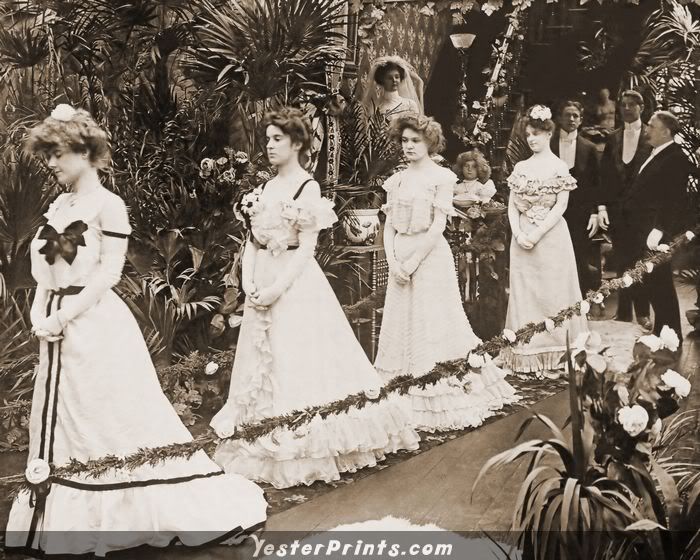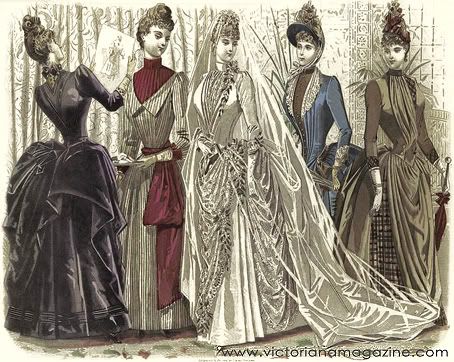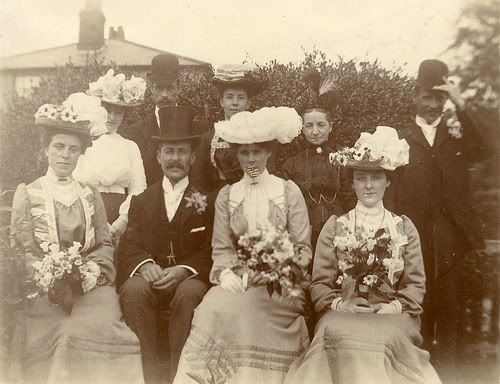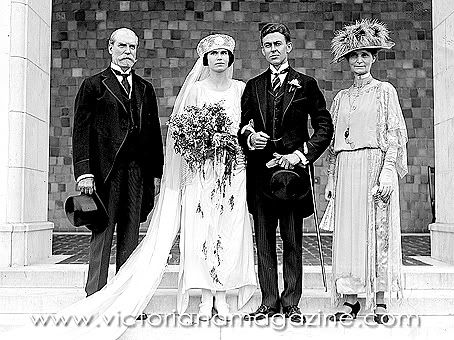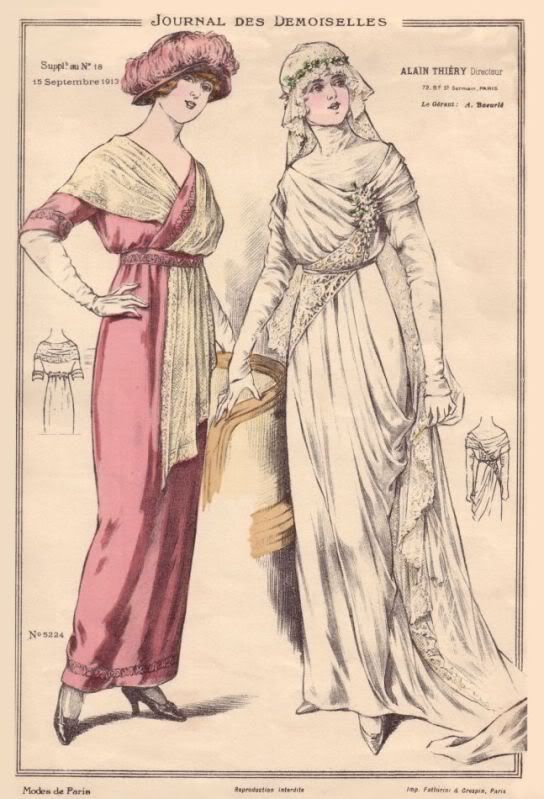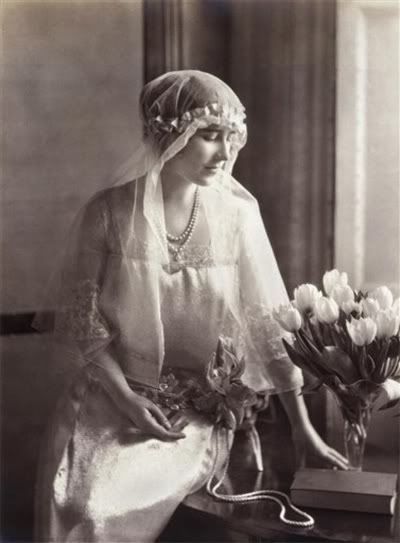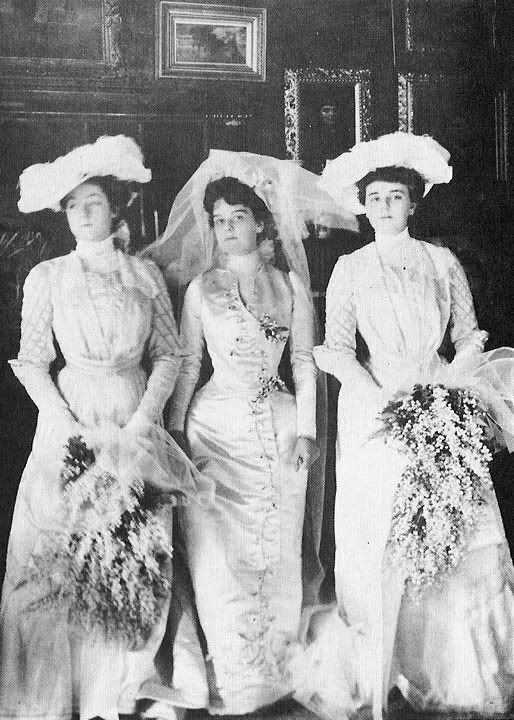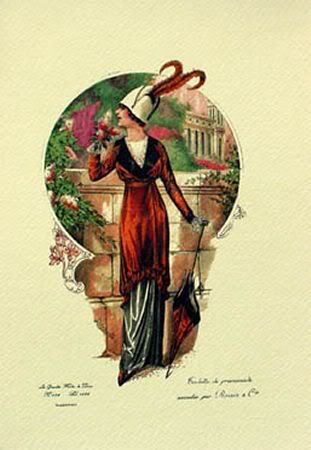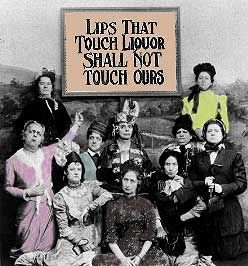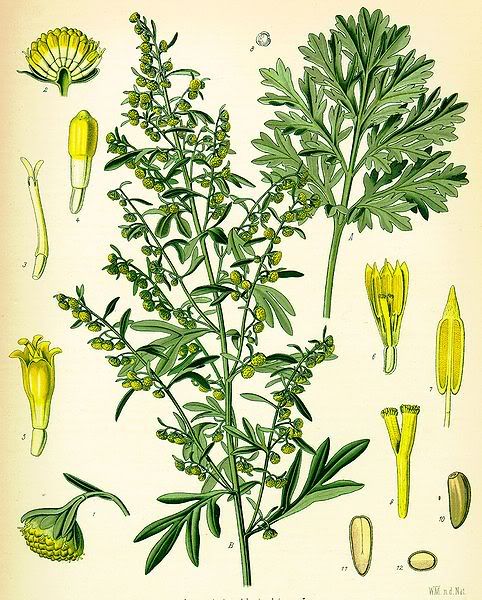The nine largest pieces after the diamond was cut:
Wednesday, September 28, 2011
The Cullinan Diamond, or Great Star of Africa
Weighing in at 530.4 carats, the Great Star of Africa, as it is referred to, was discovered in 1905 in Cullinan, a town in northeast South Africa, by miners of the Premier Diamond Mining Company. The stone was named after Sir Thomas Cullinan, owner of the mine. Purchased by the South African government, the diamond was then presented to King Edward VII on his birthday. It was later cut by the Asscher Brothers into several smaller gems.
Else von Freytag-Loringhoven
Born in 1874 when the German Empire was still in existence, Else Hildegard Plotz suffered a difficult childhood in which she was physically and sexually abused by her father. After having practiced prostitution and engaging in several affairs with both genders, she married an architect from Berlin named August Endell in 1901. The following year, Else took up with her husband's friend, Frederick Philip Grove, with August's apparent acquiescence. The trio lived together in Italy, Switzerland, and France before Else followed Grove to a farm in Sparta, Kentucky. Their relationship dissipated shortly after, and, in 1913, Else married the German baron Leopold von Freytag-Loringhoven in New York. Else modeled for artists like Marcel Duchamp and also produced many of her own works, mostly sculpture pieces and paintings, which have been identified as Dadaist. Penniless, Else returned to Berlin 10 years later. Friends found her in a state of near insanity and set her up in a flat in Paris, where she died of gas suffocation in 1927.
One of Else's most famous piece, God:
Memento Mori
So, in addition to jewelry made from hair, Victorians memorialized their loved ones by having daguerrotypes made of them. According to a contributor to Daily Oddities, "This was especially common with infants and young children; Victorian era childhood mortality rates were extremely high, and a post-mortem photograph might be the only image of the child the family ever had. ... The earliest post-mortem photographs are usually close-ups of the face of shots of the full body and rarely include the coffin. The subject is usually depicted so as to seem in a deep sleep, or else arranged to appear more lifelike. Children were often shown in repose on a couch or in a crib," often joined by a favorite toy or family member. Sometimes the subject's eyes were propped open or pupils were painted onto their eyelids. Later European examples popularly featured "the deceased in a coffin with a large group of funeral attendees.
Thursday, April 7, 2011
Aubrey Beardsley
Born in 1872, Aubrey Beardsley was an English illustrator and author who contributed to the Aesthetic and Art Nouveau movements. After completing grammar school, Beardsley worked at an architect's office and insurance company for a time before attending the Westminster School of Art in 1892. He later co-founded The Yellow Book, an influential illustrated quarterly. Many of his illustrations were grotesque and erotic. Though he was a great friend of Oscar Wilde, Beardsley was generally regarded as asexual and was completely devoted to his work. Due to chronic lung hemorrhaging, he was often unable to leave his home. A year before his death, Beardsley converted to Catholicism and begged his publisher to destroy his more obscene drawings, to which Leonard Smithers refused. Beardsley died of tuberculosis in 1898.

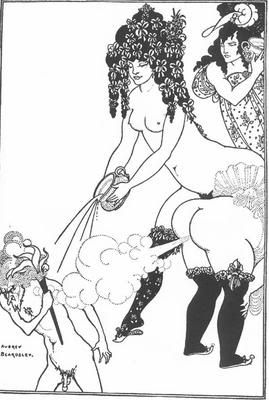
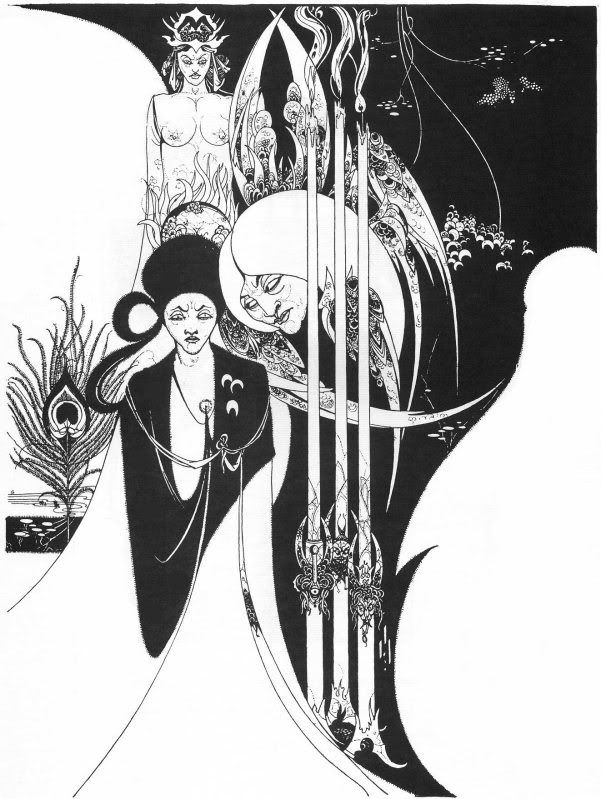



Wednesday, February 9, 2011
Folies Bergeres and Ziegfeld Follies
The music hall known as the Folies Bergere was established in 1869 Paris and still operates today. The height of its popularity lasted from the 1890s through the 1920s. It originally opened as an opera house, but switched gears and started catering to popular tastes in 1872. Shows included scantily clad girls and played up Parisian fascination with exoticism and negritude.
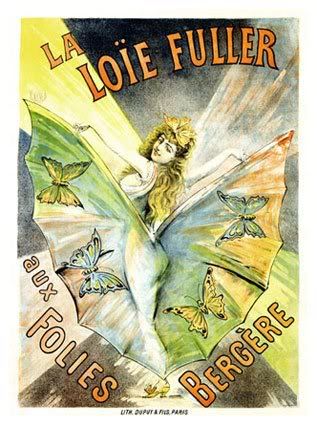
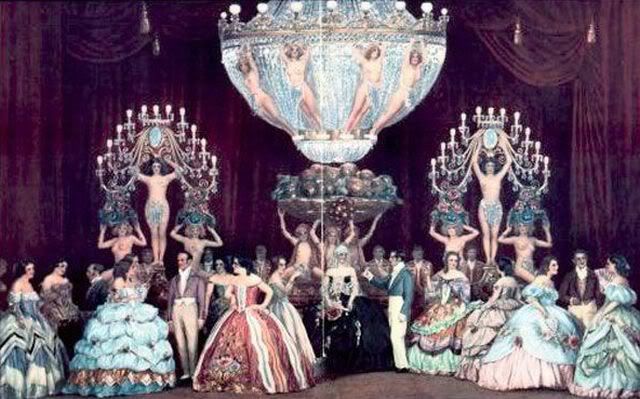
Ziegfeld Follies were a series of elaborate theatrical productions on Broadway that ran from 1907 through 1931. Conceived by Florenz Ziegfeld, the Follies were revues inspired by Paris's Folies Bergere. Entertainers like Josephine Baker and and Fanny Brice appeared in the shows. Costumes for the famous Ziegfeld chorus girls were made by such designers as Erte and Lady Duff Gordon.
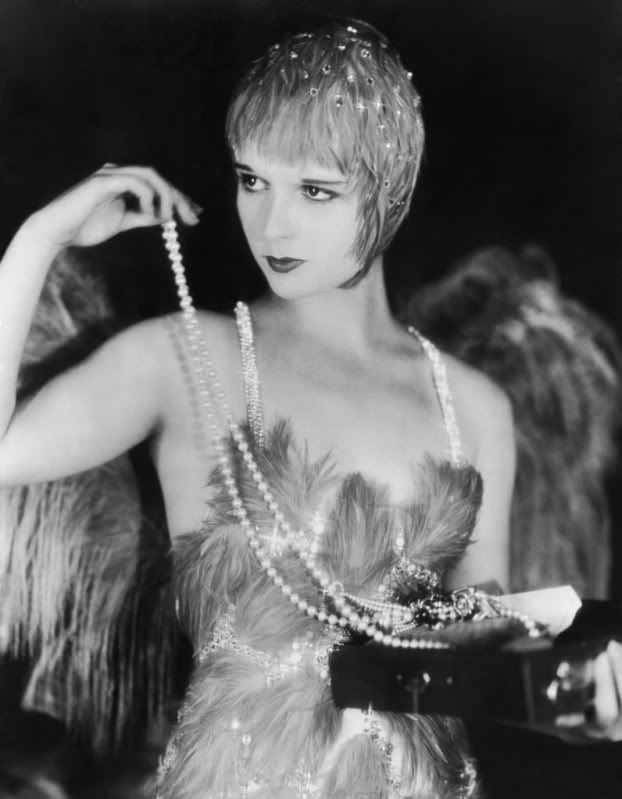
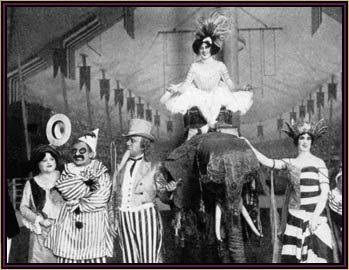
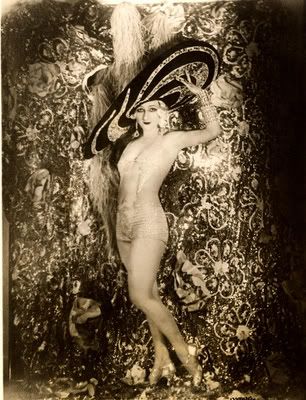
For more Ziegfeld Follies costume, click here.


Ziegfeld Follies were a series of elaborate theatrical productions on Broadway that ran from 1907 through 1931. Conceived by Florenz Ziegfeld, the Follies were revues inspired by Paris's Folies Bergere. Entertainers like Josephine Baker and and Fanny Brice appeared in the shows. Costumes for the famous Ziegfeld chorus girls were made by such designers as Erte and Lady Duff Gordon.



For more Ziegfeld Follies costume, click here.
Gilded Age Mansion No.1
I plan to do a series of brief posts on various mansions from the Gilded Age in America. This first entry is on the mansion of Payne Whitney, which is now home to the French Cultural Service Offices in New York City. The house, located on 972 Fifth Street, was completed in 1906 as a wedding gift from Whitney's uncle Colonel Oliver Payne. Stanford White began work on the Italian Renaissance palazzo-style house in 1903.
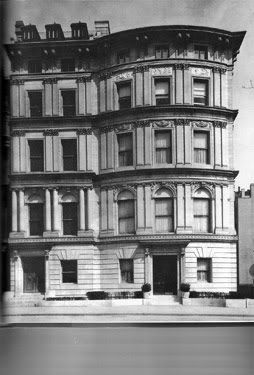
Before Whitney's wife Helen Hay died in 1944, she had her favorite room, the Venetian Room, removed and preserved. In 1987, the mansion was restored and a stained-glass window designed by John La Farge was uncovered. Today, the Payne Whitney House is designated as a New York historical landmark.

The Venetian Room, featured in the movie Rebecca.
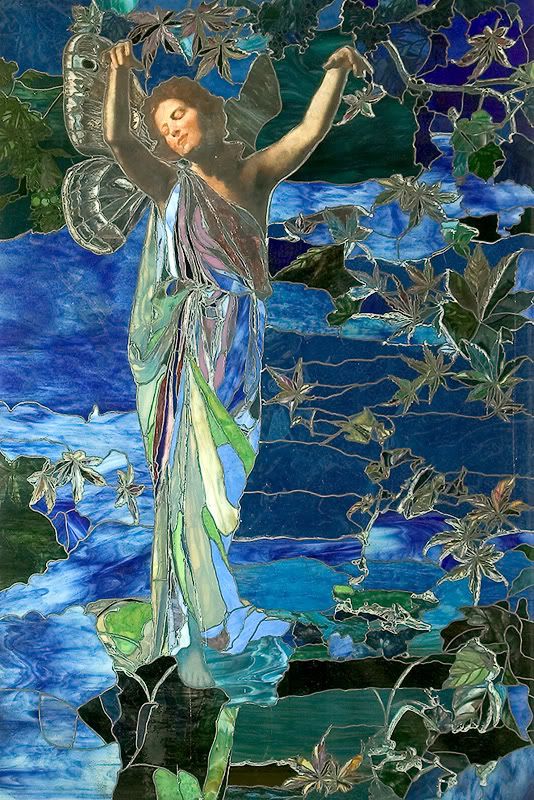
The La Farge window.
Read the full story of the Payne Whitney House here.

Before Whitney's wife Helen Hay died in 1944, she had her favorite room, the Venetian Room, removed and preserved. In 1987, the mansion was restored and a stained-glass window designed by John La Farge was uncovered. Today, the Payne Whitney House is designated as a New York historical landmark.

The Venetian Room, featured in the movie Rebecca.

The La Farge window.
Read the full story of the Payne Whitney House here.
Hair and Hats
I simply couldn't say this any better. The following text is borrowed from Eras of Elegance:
During the Victorian era, having one's hair styled by a hairdresser became popular. French hairstyles that were parted in the middle became trendy, while adorning one's head with flowers also gained stead. Austrian empress Elizabeth was the first to place flowers in her hair, and she soon started a widespread trend. "Barley curls" or "sugar curls" were long drop curls worn by children throughout the century. In the early 1840's, women took to wearing these curls alongside a coiled chignon, which was situated at the back of the head. Women continued to wear hats during this era. Fine milliners created fanciful styles decorated with plumes and ribbons. During the 1870s, the hair at the back of the head was occasionally allowed to hang loose, long and full, a lovely natural look that was featured in many pre-Raphaelite portraits. Sometimes the hair was seen in ringlets, and sometimes in large loops. In 1872, an important invention in hairstyling was invented: crimping. Crimping allowed for a "turned up hairstyle" in which the hair was pulled over a hot iron, resulting in an attractive wave. The "Marcel wave" was a new style created by the hot iron, and consisted of loose waves arranged around the head. By the end of the 1880s, pompadours were worn. This was a style in which the hair was swept up high from the forehead. Often, fake hair pieces were used to add height and depth. In addition, the "titus" hairstyle became popular from the 1880s. This hairstyle involved cutting the hair very close around the head. The hair was then curled, and styled with various ornaments including flowers. By the "Gay Nineties", high hairstyles had almost disappeared from the landscape of fashion trends. The look of the "Gibson Girl" was much more natural. A bun swept loosely on the head became the crowning feature of young Victorian girls. The "psyche knot" was especially prominent. This was basically hair pulled back from the forehead and knotted on the top of the head. Small coiffures, pompadours, and French twists were also worn, along with hair ornaments.
To see examples of hairstyles and hat fashions from the Victorian and Edwardian eras, click the picture below:
During the Victorian era, having one's hair styled by a hairdresser became popular. French hairstyles that were parted in the middle became trendy, while adorning one's head with flowers also gained stead. Austrian empress Elizabeth was the first to place flowers in her hair, and she soon started a widespread trend. "Barley curls" or "sugar curls" were long drop curls worn by children throughout the century. In the early 1840's, women took to wearing these curls alongside a coiled chignon, which was situated at the back of the head. Women continued to wear hats during this era. Fine milliners created fanciful styles decorated with plumes and ribbons. During the 1870s, the hair at the back of the head was occasionally allowed to hang loose, long and full, a lovely natural look that was featured in many pre-Raphaelite portraits. Sometimes the hair was seen in ringlets, and sometimes in large loops. In 1872, an important invention in hairstyling was invented: crimping. Crimping allowed for a "turned up hairstyle" in which the hair was pulled over a hot iron, resulting in an attractive wave. The "Marcel wave" was a new style created by the hot iron, and consisted of loose waves arranged around the head. By the end of the 1880s, pompadours were worn. This was a style in which the hair was swept up high from the forehead. Often, fake hair pieces were used to add height and depth. In addition, the "titus" hairstyle became popular from the 1880s. This hairstyle involved cutting the hair very close around the head. The hair was then curled, and styled with various ornaments including flowers. By the "Gay Nineties", high hairstyles had almost disappeared from the landscape of fashion trends. The look of the "Gibson Girl" was much more natural. A bun swept loosely on the head became the crowning feature of young Victorian girls. The "psyche knot" was especially prominent. This was basically hair pulled back from the forehead and knotted on the top of the head. Small coiffures, pompadours, and French twists were also worn, along with hair ornaments.
To see examples of hairstyles and hat fashions from the Victorian and Edwardian eras, click the picture below:
The Grand Duchess Anastasia
My first exposure to the story of Anastasia was via a traveling Romanov exhibition. Then, when the Dreamworks animated movie came out in 1997, I was officially obsessed. The film speculates what would have happened had Anastasia survived her family's assassination. It is the dream of every little girl that she is secretly a princess, so you can see why it was a success in the box office.
Velikaya Knyazhna Anastasiya Nikolayevna Romanova was born in 1901 to Tsar Nicholas II and Tsarina Alexandra. Anastasia appropriately means "breaker of chains" or "prison opener," as, in in honor of her birth, her father pardoned imprisoned students who had participated in St. Petersburg and Moscow riots in the previous year. The designation of Grand Duchess of Grand Princess indicated that Anastasia was higher in rank than other European princesses. Anastasia had strawberry-blonde hair and blue eyes.
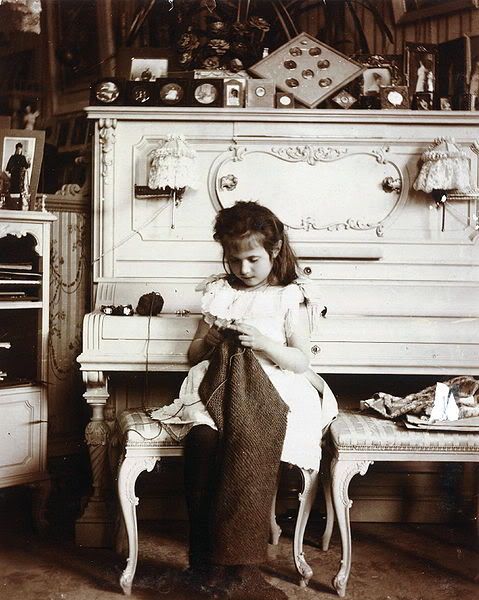
Anastasia knitting in her mother's bedroom.
She and her siblings were raised with a spartan hand; they slept on hard cots, cleaned their own rooms, and took cold baths. She was perhaps the naughtiest of the Romanov children but those closest to her also described her as vivacious and witty. Anastasia and her older sister Maria were practically inseparable. They shared a room and also each other's clothing. Older sisters Olga and Tatiana were similarly attached. Though Anastasia did not suffer from Hemophilia B like her brother Alexei, the Romanov girls showed signs of reduced bloodclotting, and reportedly, Anastasia had a weak back muscle and... bunions.
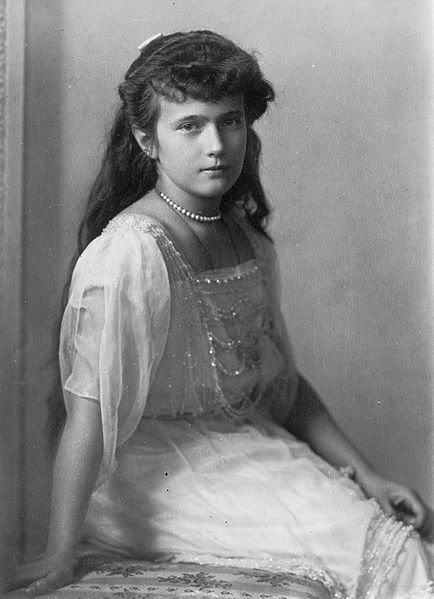
c. 1914
In 1917, Nicholas abdicated the throne and, along with his family, was put under house arrest at the Alexander Palace. Eventually, they were relocated to the Ipatiev House (or House of Special Purpose) in Yekaterinburg. After a year of fearing their impending deaths, the Romanovs were executed by firing squad on July 17, 1918.
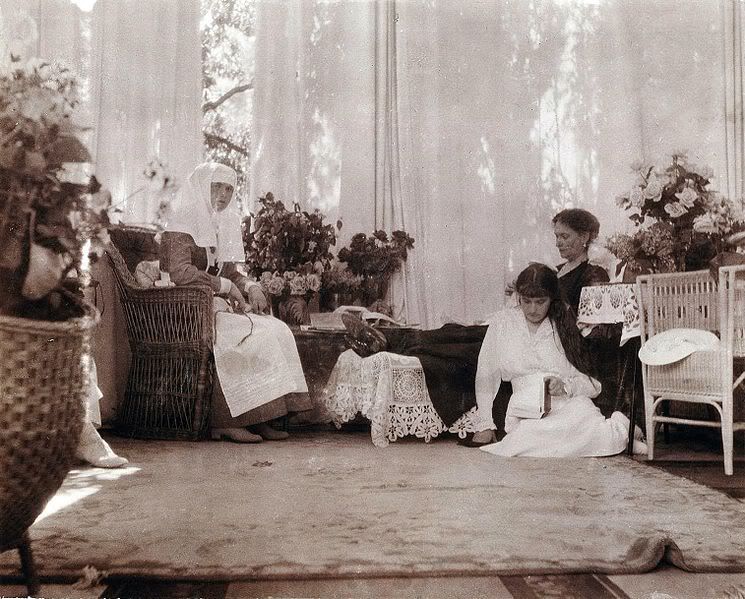
Reading next to her mother in the sitting room, c. 1916.
In the years following the deaths of the Romanov family, several women came forward to claim they were the Grand Duchess, most notably Anna Anderson, who was, by comparison of Prince Philip's DNA, proven to be an impostor. Any other rumors of Anastasia's survival were put to bed in 2007, when a Russian archaeologist announced the discovery of a burial site near Yekaterinburg. DNA testing confirmed that the remains found there were of Alexei and one of his sisters. After this discovery, all bodies of the Romanov children were accounted for and the myth of Anastasia's escape was put to bed.
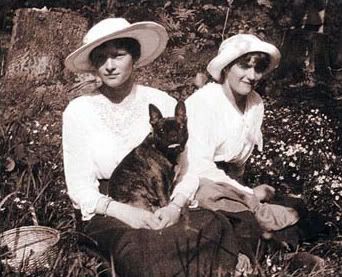
Tatiana and Anastasia with their dog Ortino in 1917.
For more photos, visit the George Grantham Bain Collection, Beinecke Rare Book & Manuscript Library, and Alexander Palace.
Velikaya Knyazhna Anastasiya Nikolayevna Romanova was born in 1901 to Tsar Nicholas II and Tsarina Alexandra. Anastasia appropriately means "breaker of chains" or "prison opener," as, in in honor of her birth, her father pardoned imprisoned students who had participated in St. Petersburg and Moscow riots in the previous year. The designation of Grand Duchess of Grand Princess indicated that Anastasia was higher in rank than other European princesses. Anastasia had strawberry-blonde hair and blue eyes.

Anastasia knitting in her mother's bedroom.
She and her siblings were raised with a spartan hand; they slept on hard cots, cleaned their own rooms, and took cold baths. She was perhaps the naughtiest of the Romanov children but those closest to her also described her as vivacious and witty. Anastasia and her older sister Maria were practically inseparable. They shared a room and also each other's clothing. Older sisters Olga and Tatiana were similarly attached. Though Anastasia did not suffer from Hemophilia B like her brother Alexei, the Romanov girls showed signs of reduced bloodclotting, and reportedly, Anastasia had a weak back muscle and... bunions.

c. 1914
In 1917, Nicholas abdicated the throne and, along with his family, was put under house arrest at the Alexander Palace. Eventually, they were relocated to the Ipatiev House (or House of Special Purpose) in Yekaterinburg. After a year of fearing their impending deaths, the Romanovs were executed by firing squad on July 17, 1918.

Reading next to her mother in the sitting room, c. 1916.
In the years following the deaths of the Romanov family, several women came forward to claim they were the Grand Duchess, most notably Anna Anderson, who was, by comparison of Prince Philip's DNA, proven to be an impostor. Any other rumors of Anastasia's survival were put to bed in 2007, when a Russian archaeologist announced the discovery of a burial site near Yekaterinburg. DNA testing confirmed that the remains found there were of Alexei and one of his sisters. After this discovery, all bodies of the Romanov children were accounted for and the myth of Anastasia's escape was put to bed.

Tatiana and Anastasia with their dog Ortino in 1917.
For more photos, visit the George Grantham Bain Collection, Beinecke Rare Book & Manuscript Library, and Alexander Palace.
Friday, February 4, 2011
Prohibition in the United States
I draw inspiration for this post from my previous one...

Backed by pietistic Protestant denominations, the movement for prohibition began in the 1840s. Those who were for prohibition were called "dries," and those against it "wets." Dries included Methodists, Northern and Southern Baptists, Presbyterians, Disciples of Christ, Congregationalists, Quakers, and Scandinavian Lutherans. Wets included Episcopalians, German Lutherans, and Roman Catholics.
The Civil War slowed the outlawing of alcohol, but it saw popularity again under the banner of the Prohibition Party and the Woman's Christian Temperance Union, founded in 1869 and 1873 respectively. One fervent supporter, Carrie Nation, drew attention by scolding saloon customers and wielding a hatchet at liquor bottles.
Prohibition, or "The Noble Experiment," lasted from 1920 to 1933. In 1917, the Senate proposed the Volstead Act, a national ban of sale, manufacture, and transportation of alcohol. Despite Woodrow Wilson's veto, the Eighteenth Amendment was ratified in 1919 and put into effect the following year. The passing of the Eighteenth Amendment produced thousands of speakeasy clubs and increased underground criminal activity.
In 1933, Roosevelt amended the Volstead Act to allow the manufacture of certain kinds of alcohol, and it was later entirely repealed in 1933.

Beer for Kids?
I am puzzled by this mid-1800s ad for Rainier Beer, suggesting that its consumption by children and senior citizens is beneficial. I thought maybe it was a root beer, as this popular soda was considered a cure-all in older days. But Rainier has been a beer brewery since 1884. Beer was thought to be safer to drink then because water was often contaminated. And I've heard that doctors once told pregnant women to drink beer... Still not sure if beer consumption by pregnant women or children was common then.
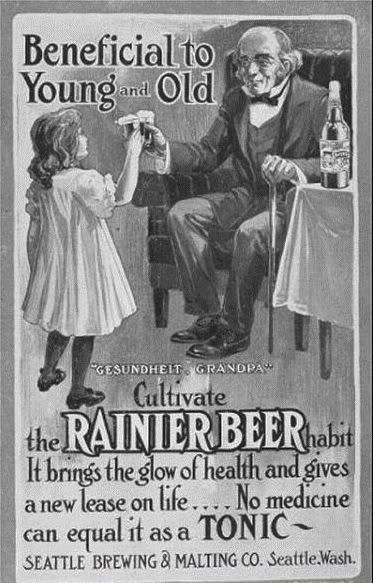

The Discovery of King Tut's Tomb
The current turmoil in Egypt has me concerned not only for the country's people but also their history. There have been reports that looters have broken into museums and tombs, destroyed mummies, and taken priceless artifacts.
Thankfully, the relics from the tomb of King Tutankhamun, today's most well-known pharaoh, are touring the United States in an exhibit, which is currently on display at the Science Museum of Minnesota. Tutankhamun ascended the Egyptian throne at the age of nine. Experts predict he died in his early 20s. He was buried in a tomb beneath his status, possibly due to an unexpected death. The location of the tomb was lost after the entrance had been damaged and subsequently built over. King Tut's tomb was discovered in 1922 by archaeologist and Egyptologist Howard Carter and George Herbert, 5th Earl of Carnarvon, the financer of the excavation. Carter began excavating sights in the Valley of the Kings in 1908. It was Carter's water carrier who found the steps leading to Tutankhamun's tomb.
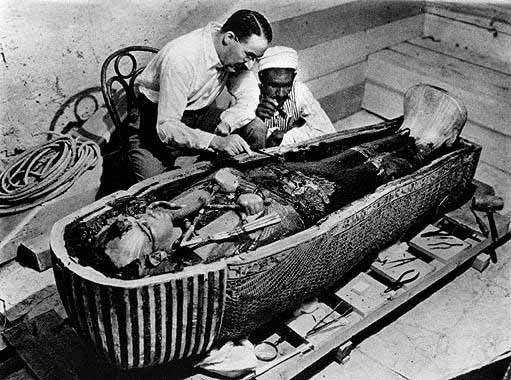
Carter with Egyptian worker.
King Tut has inspired public interest since the tomb's discovery. Recently, scientific tests were conducted on Tutankhamun's mummy. In addition to concluding King Tut was a product of incest, scientists found signs of scoliosis, an overbite, and a slightly cleft palate. Scientists believe Tutankhamun's cause of death was due to a combination of a broken, infected leg and malaria.
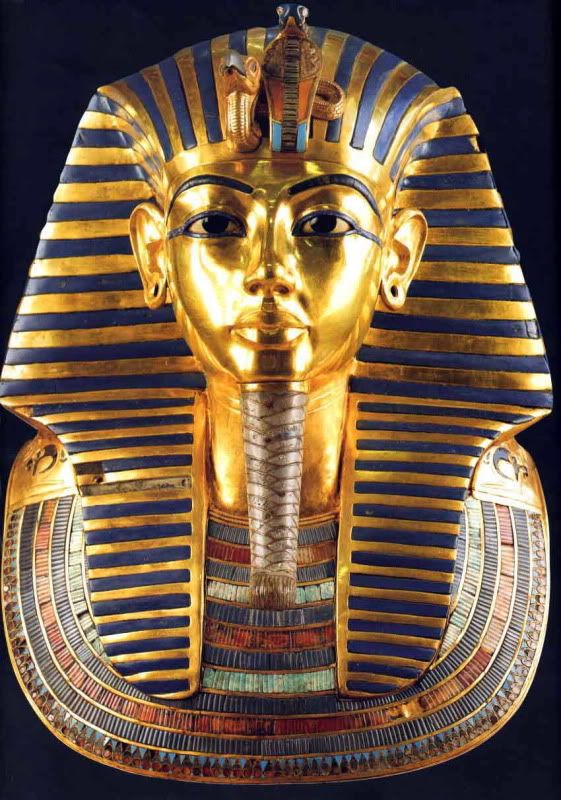
Thankfully, the relics from the tomb of King Tutankhamun, today's most well-known pharaoh, are touring the United States in an exhibit, which is currently on display at the Science Museum of Minnesota. Tutankhamun ascended the Egyptian throne at the age of nine. Experts predict he died in his early 20s. He was buried in a tomb beneath his status, possibly due to an unexpected death. The location of the tomb was lost after the entrance had been damaged and subsequently built over. King Tut's tomb was discovered in 1922 by archaeologist and Egyptologist Howard Carter and George Herbert, 5th Earl of Carnarvon, the financer of the excavation. Carter began excavating sights in the Valley of the Kings in 1908. It was Carter's water carrier who found the steps leading to Tutankhamun's tomb.

Carter with Egyptian worker.
King Tut has inspired public interest since the tomb's discovery. Recently, scientific tests were conducted on Tutankhamun's mummy. In addition to concluding King Tut was a product of incest, scientists found signs of scoliosis, an overbite, and a slightly cleft palate. Scientists believe Tutankhamun's cause of death was due to a combination of a broken, infected leg and malaria.

Sears, Roebuck and Co.
Have you ever been to Sears? Did you know that it's been around since the late 1800s? It all began when railroad station agent Richard Warren Sears started selling watches though mail order catalogues. When he moved to from North Redwood, Minnesota Chicago, he became business partners with Alvah C. Roebuck. Originally geared towards farmers who shopped at general stores, the first catalogue was printed in 1888, and by 1894, it was 322 pages. The catalogue featured anything from sewing machines to automobiles. You could even purchase a kit to make a house.
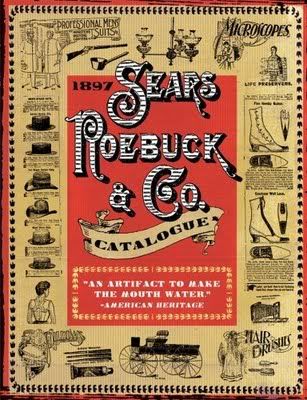

A houseplan from 1909.


A houseplan from 1909.
Renee Lalique
Renee Lalique (1860-1945) was raised in paris as a child. He attended London's Sydenham Art College for two years. After designing for jewelers like Cartier, he opened his own jewelry and glass store to much success. His work is associated with both Art Nouveau and Art Deco styles. His granddaughter Marie Claude-Lalique (1936-2003) was also a glass maker working in Fort Meyers, Florida.
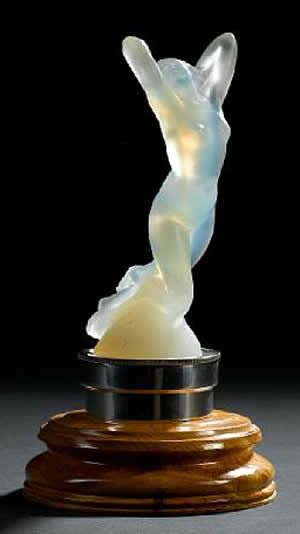
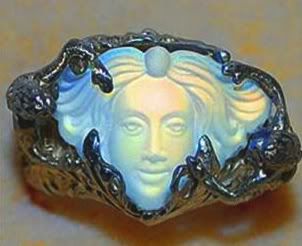


19th Century Paper Dolls
I found this unique blog on 19th century paper dolls. Check it out by clicking the image below:
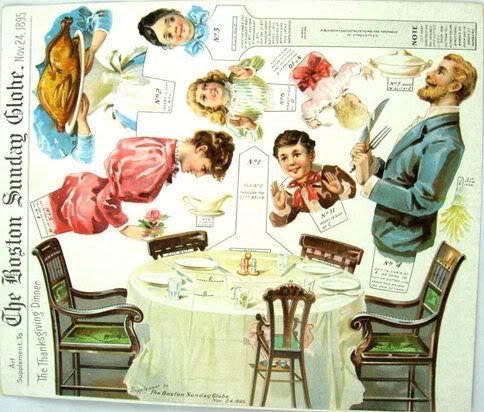
I also came across a blog on Victorian Studies, if you're in the mood for something more academic.

I also came across a blog on Victorian Studies, if you're in the mood for something more academic.
Daguerrotype
I bought a daguerrotype! The frame was in such perfect condition, I had to have it. The hinges, hook and eye, velvet, and gold trim are all intact, which is rare. The man in the picture almost looks as if he has curls that come down over his ears, like the payot (sidecurls) of Hasidic Jewish men... But I think he would have to have had a longer beard and perhaps different dress. I guess he just had some unruly sideburns.
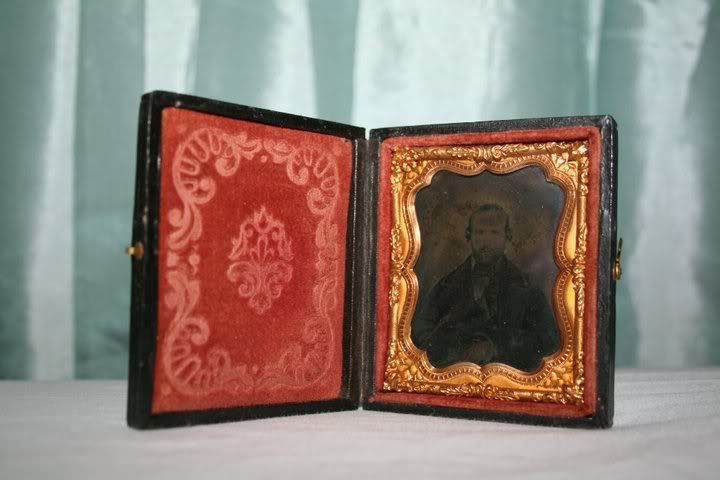
P.S. The daguerrotype was invented by Louis Daguerre and Joseph Nicephore Niepce in 1839. The image is formed with the alloy of mercury and silver. It can be easily smudge or damaged, so they were sealed in cases or frames like this one.

P.S. The daguerrotype was invented by Louis Daguerre and Joseph Nicephore Niepce in 1839. The image is formed with the alloy of mercury and silver. It can be easily smudge or damaged, so they were sealed in cases or frames like this one.
Sunday, January 23, 2011
Les Fleurs Animees (1847)
I was thumbing through some antique prints in a shop a few weeks ago and came across a unique colored plate from a 1847 book called Les Fleurs Animees, illustrated by J. J. Grandville. I'm not French scholar, but I believe it translates to The Animated Flowers, animated in that the difference between this book and other botanical pictorials is that these flowers have human faces and characteristics.
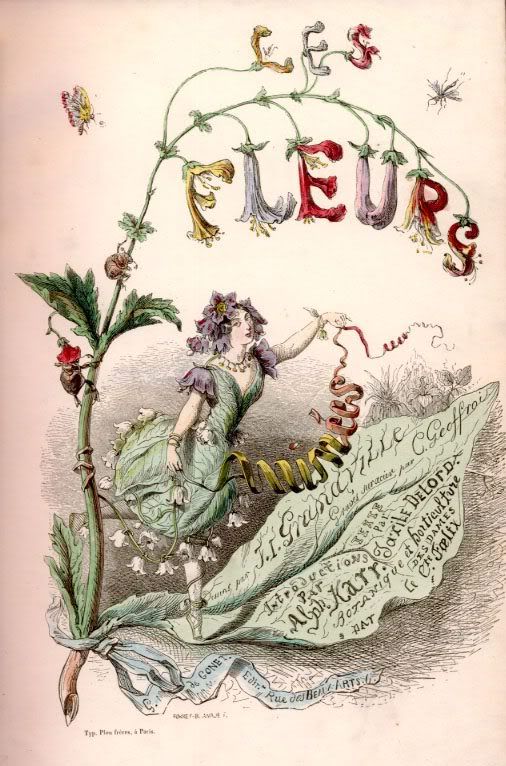
Many of the illustrations are based on the flower or plant's namesake, such as the Narcissus.
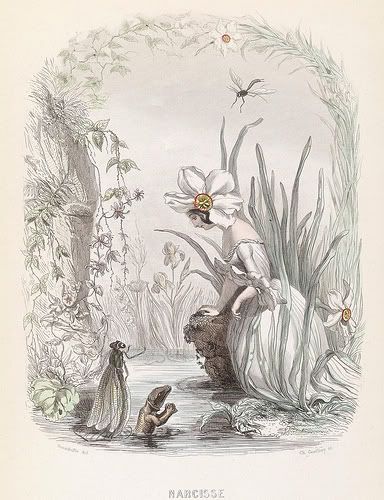
Some of them are cheeky or amusing, like these Hawthorn (Aubepine in French) which are about to be trimmed.
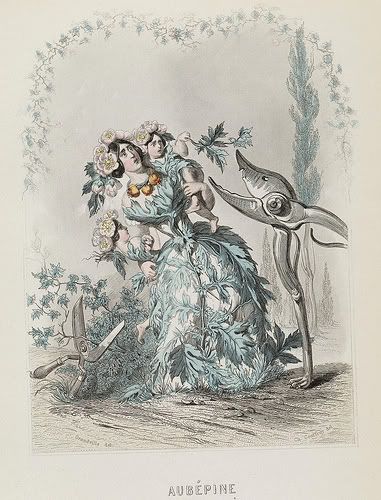
I've found the book and its individual prints for sale online in various places, but it does seem to be somewhat rare. A framed print from Les Fleurs Animees would make for a lovely decoration of any room.
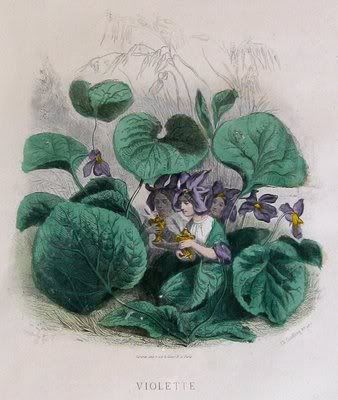

Many of the illustrations are based on the flower or plant's namesake, such as the Narcissus.

Some of them are cheeky or amusing, like these Hawthorn (Aubepine in French) which are about to be trimmed.

I've found the book and its individual prints for sale online in various places, but it does seem to be somewhat rare. A framed print from Les Fleurs Animees would make for a lovely decoration of any room.

Brooklyn Bridge 1899
I thought this video was really cool, especially for people who are familiar with New York. This footage of the Brooklyn Bridge was filmed by Thomas Edison in 1899.
Tuesday, January 11, 2011
The Princess and the Goblin
When I was a kid, the 1992 film The Princess and the Goblin was one of my favorite movies. I was surprised to find out that it is actually based on a children's novel by George MacDonald. The novel was published in 1872 by by Strahan & Co, and its sequel published in 1883. Critic Jeffrey Holdaway describes both books as initially "normal fairytales" that "slowly become stranger," and they contain layers of symbolism similar to Lewis Carroll's work. George MacDonald was a Scottish author, poet, and Christian minister who influenced other authors like W.H. Auden, J.R.R. Tolkein, C.S. Lewis, Mark Twain, and Madeleine L'Engle. I've heard of MacDonald before but I had no idea of his work in fantasy and children's literature or that he, a simple minister, impacted so many famous authors.
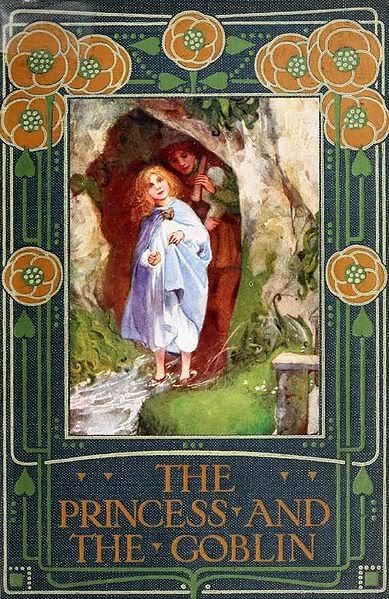
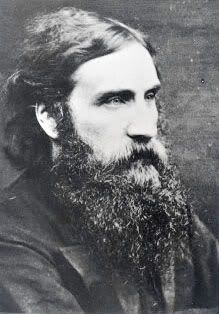


Absinthe
Absinthe is an anise-flavored spirit and is usually green in color but can also be clear or milky. In literature, absinthe is commonly referred to as le fee verte, the green fairy. Absinthe contains the chemical thujone and was banned in many countries because it was thought to contain an addictive psychoactive drug, but there is no evidence that absinthe is more harmful than any other spirit.

Absinthe was traditionally poured over a sugar cube, as seen here.
Absinthe has been around since the mid-1500s but reached its popularity in the 1840s when it was given to French troops as a malaria treatment. Absinthe then became popular in bars and cabarets, and by the 1860s, 5 p.m. in Paris was called l'heure verte, the green hour. Mass production caused the price of absinthe to drop and the French were drinking 36 million litres of absinthe a year by 1910. Absinthe also enjoyed popularity in Spain, the Czech Republic, and New Orleans. The Old Absinthe House on Bourbon Street was frequented by Mark Twain, Oscar Wilde, Franklin Roosevelt, and Frank Sinatra. Absinthe was banned in many countries due to its high alcoholic content and supposed hallucinogenic effects, but one can purchase it in the States today, as the ban on absinthe was lifted in 2007.
Absinthe was traditionally poured over a sugar cube, as seen here.
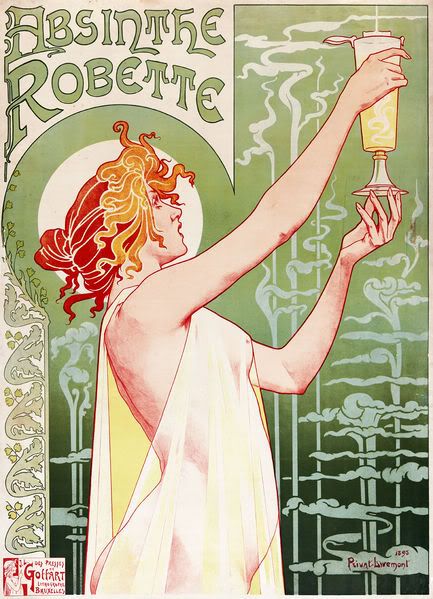
Poster by Henri Privat-Livemont, 1896.
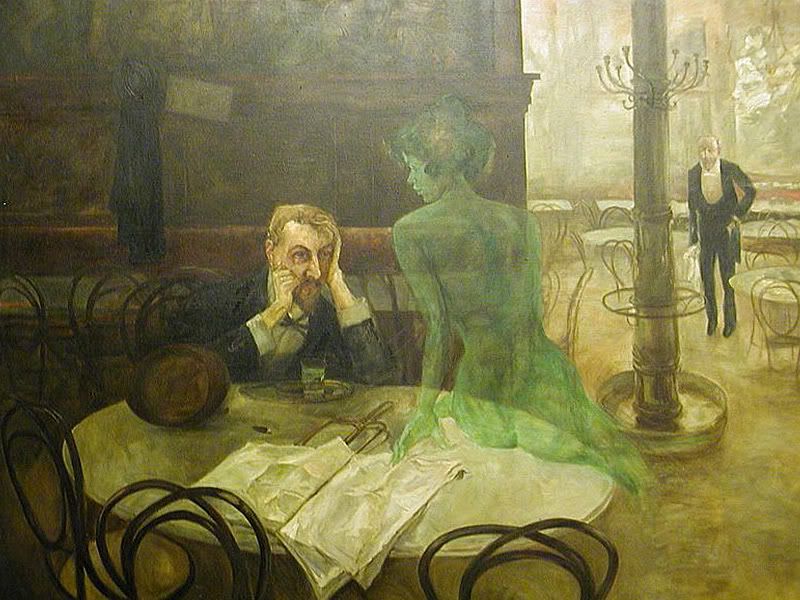
The Absinthe Drinker, by Viktor Oliva (1861-1928)
Subscribe to:
Posts (Atom)







